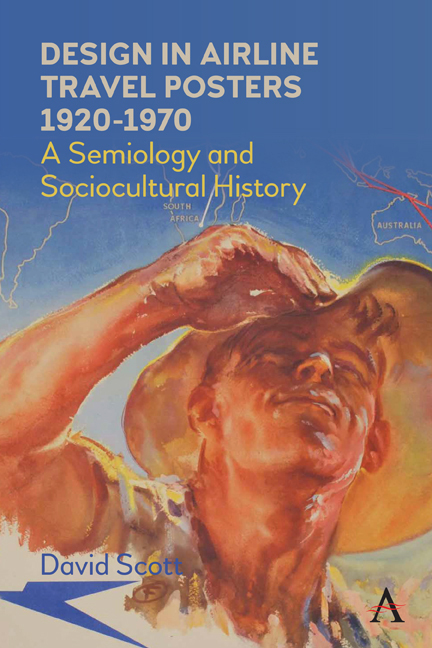Book contents
- Frontmatter
- Dedication
- Contents
- List of Figures
- Introduction
- 1 Fact and Fantasy: Reading and Misreading the Poster Image
- 2 People, Places and Planes: Destinations and Itineraries
- 3 Looking Out and Looking Up: Framing Devices and Indexical Signs
- 4 Indigenous Peoples
- 5 Glamour and Sex Appeal: Designing Desire
- Conclusion: The Decline of the Airline Travel Poster
- References
- Index
2 - People, Places and Planes: Destinations and Itineraries
Published online by Cambridge University Press: 09 February 2021
- Frontmatter
- Dedication
- Contents
- List of Figures
- Introduction
- 1 Fact and Fantasy: Reading and Misreading the Poster Image
- 2 People, Places and Planes: Destinations and Itineraries
- 3 Looking Out and Looking Up: Framing Devices and Indexical Signs
- 4 Indigenous Peoples
- 5 Glamour and Sex Appeal: Designing Desire
- Conclusion: The Decline of the Airline Travel Poster
- References
- Index
Summary
Imperial Itineraries
The development from the 1920s of the classic continental or intercontinental itineraries by small but growing airlines was a response in particular to the need to provide rapid transport for both mail and passengers. For the victorious post-World War I European powers (Britain, France and the Netherlands) this meant servicing the routes to their imperial/colonial colonies and dominions as flown by Air Orient (later Air France), Imperial Airways (later BOAC) and KLM (Royal Dutch Airlines), while for American airlines (especially Pan American) it meant covering their sphere of influence with ‘Clipper’ services to South and Central as well as to North America, using both land and sea planes. At the same time, the growing demand on the part of a wider European and American public in the 1920s and 1930s for travel (business or pleasure-related) to the exotic parts of the world – India, Ceylon, Indonesia and to the colonial dominions in Africa, Australia and New Zealand – resulted in the establishment of a number of world-wide air networks. Very soon European airlines were claiming to travel to ‘All six continents’, to fly ‘Dans tous les ciels’ and generally reducing intercontinental travel times to a matter of days rather than weeks.
As a result of this, in the 1930s, the globe or map of the world naturally became a central motif in airline advertising, particularly for European airways. KLM, servicing Dutch interests in the Far East, in particular Indonesia, and in Europe, reminded the public through their posters of the extent and regularity of their flights. So, in a poster of the 1930s (Figure 2.1), a KLM Douglas DC 3 (Dakota) is seen flying above a globe on which are marked KLM routes from Amsterdam across Europe to Cairo, Bagdad, Karachi, Calcutta, Rangoon and Bangkok to the final destination in Batavia (which today we call Jakarta), a journey which in its entirety then took five and a half days, available in both directions twice weekly. A similar approach was taken by KLM to its European routes (Figure 2.2), which flew from Amsterdam as far south as Milan, especially when, after its launch in 1919, the service established its profile as a major continental airline, with regular flights from, for example, Amsterdam to London initiated as early as 1920.
- Type
- Chapter
- Information
- Design in Airline Travel Posters 1920–1970A Semiology and Sociocultural History, pp. 25 - 58Publisher: Anthem PressPrint publication year: 2021



